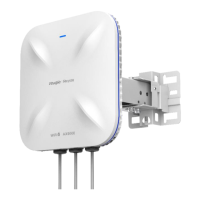Cookbook Advanced Solution Guide
98
Reject: When receiving a decade packet in unicast mode, the device with a higher priority sends a Reject packet
according to the election priority.
Join: The Join packet is broadcast by the master. When other devices in initial state receive the packet, they
will connect to the master according to master information in it.
Conflict: The master sends a Conflict packet in unicast mode when receiving a Join packet from another master.
As a result, the slave cannot resolve the packet according to the conflict handling algorithm.
Merge: The master sends a Merge packet in unicast mode when receiving a Join packet from other master
devices. In this case, the master combines Join packets from other masters according to the conflict handling
algorithm.
Hello: All devices start broadcasting Hello packets after the role status is confirmed for neighbor discovery.
Master Election
Priority:
(1) EG > AP > switch
(2) Device model: device CPU/memory/other information (AP radio number)
(3) When the priorities are the same, the device with a larger MAC address will be the master.
Select the master.
Re-select the master.
Master Preemption Mechanism
If a device with a higher priority joins a network, the master device will change. The new device will send a
Merge packet to the master device.
For AP networking, after the master is selected, if a new EG is added, the EG will become the master.
Preemption time: 7-8s
For AP networking, after the master is selected, if a new AP with a higher priority is added, the preemption is
delayed.

